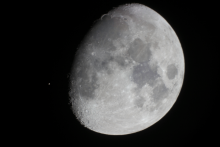Listen to today's episode of StarDate on the web the same day it airs in high-quality streaming audio without any extra ads or announcements. Choose a $8 one-month pass, or listen every day for a year for just $30.
You are here
Moon and Aldebaran
For Aldebaran, it’s the beginning of the end. The bright orange star stands to the lower left of the Moon as they rise late this evening, and even closer to the upper left of the Moon at first light tomorrow.
Aldebaran has completed its long run in the prime of life and now is in the early stages of its demise. This process will end in a few hundred million years, when all that remains will be the star’s dead core.
Right now, the core is in a holding pattern. Nuclear reactions have converted its original hydrogen to helium. Reactions are still taking place in a thin layer around the core, but not in the core itself. The core is shrinking and getting hotter, causing Aldebaran’s outer layers to expand and cool. In fact, Aldebaran is more than 40 times wider than the Sun.
Over millions of years, the core will get hot enough to ignite nuclear reactions in the helium. The outer layers will shrink a bit while Aldebaran burns through the helium.
When the helium in the core runs out, the star will briefly get its energy from shells of helium and hydrogen around the core.
As the hydrogen and helium take turns switching on and off, Aldebaran will pulse in and out like a beating heart. Each pulse will expel some of the star’s gas into space. Eventually, all the gas in the outer layers will stream into space, forming a colorful cocoon of gas and dust. This cocoon will quickly dissipate — leaving only the star’s hot but dead core.
Script by Damond Benningfield



